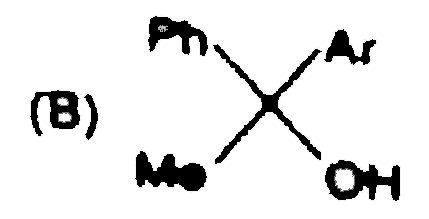(C2H5O)2COCH3MgBr(excess)−−−−−−−−−−−→H3O+A.A (alcohol) can also be obtained by :
CH3CH2CHOCH3MgBr(2mol)−−−−−−−−−−→H3O+
CH3O∣∣COC2H5CH3MgBr(2mol)−−−−−−−−−−→H3O+
CH3O∣∣CCH3CH3MgBr(1mol)−−−−−−−−−−→H3O+
as in (b) and (c)
The correct Answer is:D
Compound (A) is CH3−OH∣C∣CH3−CH3, (b) & (c) give (A)

Topper's Solved these Questions
- GRIGNARD REAGENTSBOOK - MS CHOUHANCHAPTER - GRIGNARD REAGENTSEXERCISE - Level 1 (Q.61 To Q.66)
1 Videos
- GENERAL ORGANIC CHEMISTRYBOOK - MS CHOUHANCHAPTER - GENERAL ORGANIC CHEMISTRYEXERCISE - LEVEL- 1
1 Videos
- ISOMERISM (STRUCTURAL & STEREOISOMERISM)BOOK - MS CHOUHANCHAPTER - ISOMERISM (STRUCTURAL & STEREOISOMERISM)EXERCISE - Subjective Problems
17 Videos
Similar Questions
Knowledge Check
Et−O−O∣∣C−O−Et(1)CH3MgBr(excess)−−−−−−−−−−−−−−→(2)H3O⊕(A), Process (A) is :
ACH3−O∣∣C−O−EtBCH3−O∣∣C−CH3CCH3−OH∣C∣CH3−CH3DCH3−CH2−CH3Phenyl acetate (i)CH3MgBr(excess)−−−−−−−−−−−−−→(ii)H⊕'P' 'P' can be
A B
B C
C D
D
CH3COOC2H5CH3MgBr−−−−−→excessP. The product P will be
A B
B C
C D
D
CH3O∣∣CCH2CH2CH2ClCH3MgBr−−−−−→△A.
A is :
View SolutionConsidering the following reactions (I,II,III) and give your answer for following question.

(i)CH3MgBr(excess)−−−−−−−−−−−−−→(ii)H3O⊕
(III)(a)EtO−O∣∣C−OET(i)PhMgBr(excess)−−−−−−−−−−−−→(ii)H+
(b)EtO−O∣∣C−OET(i)CH3MgBr(excess)−−−−−−−−−−−−−→(ii)H+
(c )H−O∣∣C−OET(i)PhMgBr(excess)−−−−−−−−−−−−→(ii)H+
(d)H−O∣∣C−OET(i)CH3MgBr(excess)−−−−−−−−−−−−−→(ii)H+
(e)ClCH2COOEt(i)CH3MgBr(excess)−−−−−−−−−−−−−→(ii)H+
In which set of the reactions in (III) the product will be 2∘ alcohol ?
View SolutionConsidering the following reactions (I,II,III) and give your answer for following question.

(i)CH3MgBr(excess)−−−−−−−−−−−−−→(ii)H3O⊕
(III)(a)EtO−O∣∣C−OET(i)PhMgBr(excess)−−−−−−−−−−−−→(ii)H+
(b)EtO−O∣∣C−OET(i)CH3MgBr(excess)−−−−−−−−−−−−−→(ii)H+
(c )H−O∣∣C−OET(i)PhMgBr(excess)−−−−−−−−−−−−→(ii)H+
(d)H−O∣∣C−OET(i)CH3MgBr(excess)−−−−−−−−−−−−−→(ii)H+
(e)ClCH2COOEt(i)CH3MgBr(excess)−−−−−−−−−−−−−→(ii)H+
If CH3MgBr is taken in excess in reaction (I), how many moles of CH3MgBr will be consumed in reaction (I)
View SolutionConsider the following sequence of reactions.
C6H6+CH3CH=CH2H3PO4−−−→heatA1.O2,heat−−−−−→2.H3O+B+C
The products (B) and (C) are:
View SolutionC4H8O2Ester (X) (i)CH3MgBr−−−−−−−−−→(ii)HOH/HClC4H10OAlcoholY
Alcohol (Y) gives Lucas test within 5 minutes. Thus, (X) and (Y) respectively are:
View Solution
